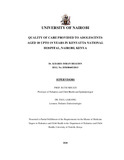| dc.description.abstract | Background: A health care system that seeks to improve the quality of care across all
population groups must ensure that it provides health care that is; Effective, Accessible,
Acceptable, Equitable and Safe. In developing countries, adolescent health care
remains a gray area and in Kenya, adolescents make up 24% of the total population.
This study explored the nature of Adolescent Health Care, in both the inpatient and
outpatient settings at Kenyatta National Hospital, the largest referral hospital in Kenya.
This study was conducted at KNH Filter Clinic including Pediatric filter clinics for ages
10-12 years, walk in clinic for age >12 years as well as specialty clinics and adolescents
admitted inpatient.
Goal: To describe the quality of care provided by Health Care Providers attending to
patients aged between 10 and 19 years seeking care at Kenyatta National Hospital.
Study design: A mix- method research design was used combining quantitative and
qualitative approaches. A descriptive cross-sectional survey was conducted together
with focus group discussions involving adolescents and health care professionals.
Primary Objective: To describe and compare the quality of care provided to
adolescents [aged 10 to 19 years] both in the inpatient and outpatient clinics in Kenyatta
National Hospital against the WHO Global Standards for Quality Health-Care Services
for Adolescents [2015].
Secondary Objectives: To identify gaps faced by the Hospital and Health Care
Providers in providing for the needs of adolescents and to determine the barriers and
challenges faced by Adolescents receiving health care in Kenyatta National Hospital.
Methodology: All study participants were provided consent before participating in the
study. For an adolescent who was less than 18 years of age to participate in the study,
a consent was sought from the parent/guardian of the adolescent. Data was collected
using structured interviewer based questionnaires. These included 1) Adolescent client
exit interview tool, 2) Health facility manager interview tool and 3) Health-care
provider tool.
We collected data on social-demographic characteristics and quality of health care
aspects using a scored quality of care tool. Eight standards of Quality Care, centered
around adolescent health care, were measured which included: Adolescents’ health
literacy, Community support, Appropriate package of services, Health Care Provider
Competencies, Facility characteristics, Equity and non-discrimination, Data and quality
improvement and Adolescents’ participation.
Results: Adolescents who were more likely to report acceptable quality of service were
older (p<0.0001), coming for a repeat visit (p=0.03), those who saw the signboard
(p<0.0001), those who were supported using the facility by guardians (p=0.026) as well
as those who got the services they came for (p=0.033). Older age (OR 1.5, p<0.0001)
and accompaniment by parents/guardians (OR 0.5, p=0.006) were independently
x
associated with acceptable quality of care. There was very limited training on
adolescent care reported by the Health Care Providers (21.7%). Overall, 73.9% of the
Health Care Providers were not aware of Adolescent Care SOPs and guidelines.
According to the WHO Criteria, 69% of the services offered did not meet the quality
threshold. Assessing the quality of services as per the 8 WHO standards of quality
health care in adolescents, the services offered need some improvement with respect to
Standard 5 and 6, needs major improvement for the rest of the standards except
Standard 8 which does not meet the quality care standards.
Conclusion: KNH performed overall poorly in meeting theWHO standards of quality
health care in adolescents. It can be concluded that the quality of care provided to
adolescents at Kenyatta National Hospital requires significant improvement despite the
adolescents’ overall good perception.
Recommendation: Active adolescent involvement is needed in the planning,
monitoring and evaluation of their health services. There is need to train health-care
providers in order that they can be competent in providing effective health services to
adolescents. Adolescents health rights and knowledge practices is vital as part of
health-care provision by health care providers. An adolescent client database to follow
up patients after their visits, as well as allow for the health facility to collect, analyse
and use data on service utilization and quality of care to support quality improvement
is required. The Facility requires more visual information e.g signs-boards, and posters
on services provided as well as operational times. The accompaniment by a guardian
or parent needs to be discussed as part of the overall visitation guidance by the health
care provider. | en_US |



